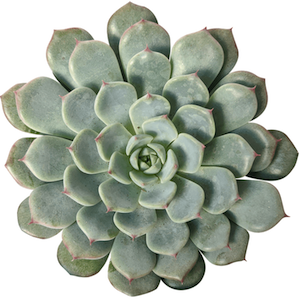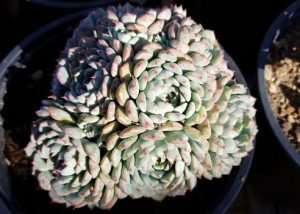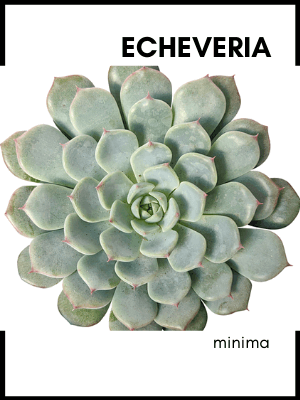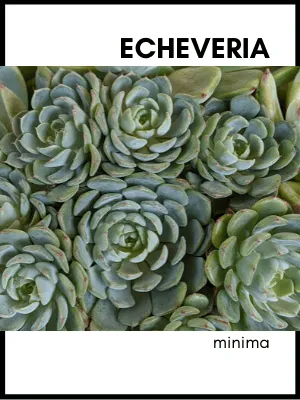Echeveria minima Care Guide
Echeveria minima is a gorgeous succulent that is popular among gardeners and succulent enthusiasts. This plant is native to Mexico and is a member of the Crassulaceae family. Echeveria minima is a small succulent that grows up to 3 inches in diameter and height, making it a perfect plant for small spaces or as part of a succulent arrangement. It is characterized by its rosette shape and beautiful blue-green leaves that have a powdery coating, which helps the plant retain moisture.
How to Care for Echeveria minima
Echeveria minima is a low-maintenance succulent that is easy to care for. To help this plant thrive, you need to provide it with the right growing conditions. Here are some tips for caring for Echeveria minima.
Light
Echeveria minima needs bright, indirect light to grow well. It can tolerate some direct sunlight, but too much can scorch its leaves. Place your plant near a window that gets plenty of natural light or use a grow light to supplement the light if necessary.
Soil
Echeveria minima prefers well-draining soil that is rich in organic matter. A mixture of cactus soil and perlite or sand works well for this plant. Make sure the soil is dry before watering to prevent root rot.
Watering
Echeveria minima is drought-tolerant and prefers to be watered thoroughly when the soil is completely dry. It is best to water this plant from the bottom to prevent water from getting on its leaves. Overwatering can cause the roots to rot, leading to the plant’s demise.
Temperature
Echeveria minima thrives in temperatures between 60-75°F (15-24°C). It can survive in lower temperatures, but it is best to keep the succulent away from freezing temperatures.
Fertilizer
Echeveria minima does not require fertilizer, but you can feed it once a month during the growing season (spring and summer) with a diluted succulent fertilizer.
Propagating
Propagating Echeveria Minima is a fun and easy way to grow your collection of succulents. Here’s how to do it:
Leaf Propagation
To propagate Echeveria minima from a leaf cutting, gently remove a leaf from the mother plant, let it dry for a few days, and then place it on top of a well-draining soil mix. Mist the soil occasionally, and in a few weeks, you will notice small plantlets growing from the base of the leaf.
Stem Propagation
To propagate Echeveria minima from a stem cutting, cut a healthy stem from the mother plant, let it dry for a few days, and then plant it in well-draining soil. In a few weeks, you will notice roots growing from the base of the stem.
Common Problems and Solutions
Echeveria minima is a hardy succulent, but it can still encounter some problems. Here are some common issues and solutions for this plant:
Overwatering
Overwatering can cause the roots of Echeveria minima to rot, leading to the plant’s demise. To avoid this, water only when the soil is completely dry, and make sure that excess water is drained out of the pot. It’s also best to use a well-draining soil mix and a pot with drainage holes to prevent water from accumulating at the bottom.
Underwatering
Underwatering is also a common problem for Echeveria minima. If the leaves of the plant are thin and wilted, it’s an indication that the plant needs more water. Water the plant deeply and ensure that the water reaches the roots.
Pest infestations
Echeveria minima can be vulnerable to mealybugs, spider mites, and scale insects. These pests can be easily spotted on the plant’s leaves, and they can damage the plant if not dealt with promptly. The most effective way to deal with these pests is to wipe the leaves with a damp cloth or use insecticidal soap.
Sunburn
Echeveria minima prefers bright but filtered sunlight, and direct sunlight can cause sunburn, leading to the leaves turning brown. If the plant is exposed to too much sun, it’s best to move it to a shadier location to allow it to recover.
Growing Season:
Summer
Dormant Season:
Winter
Hardy to USDA Zone: 10a- Size: Up to 3″ wide rosettes
- Foliage: Blue/Green
- Flower: Orange/Pink
Propagation: Stem cuttings, leaves, seed, offsets
Light: Part sun, bright shade
Water: Drench & Dry
Soil: Gritty, mostly inorganic, quickly draining- Origin: Mexico

About Echeveria minima
Echeveria minima was first described by Jorge Meyran in 1968. Its name refers, obviously, to its small size. Everything about it is mini and I love it. The bluish leaves are tightly packed together and the tips take on a pinkish blush color when stressed. They tend to form tightly packed clumps.
Since the leaves on Echeveria minima are so tightly packed together, take special care to water the soil around it instead of overhead. Water will easily stay trapped between the leaves and cause it to rot.
Definitely check out: How to Water Succulents So They Don’t Die
Echeveria minima is one of the more tender Echeveria species I have in my collection and does the best in terracotta pots so it can be moved around depending on the time of the year. I keep it protected from direct sun in the heat of the summer.
You might like: My Succulent Leaves Are Turning Yellow
Propagating it by taking cuttings is the easiest way to do it. The leaves are so thin and tender that they usually end up drying out before it has a chance to form roots or leaves.
Quick question: Should you mist succulents? Find that answer here.

Click here to read the full Echeveria Care Guide


